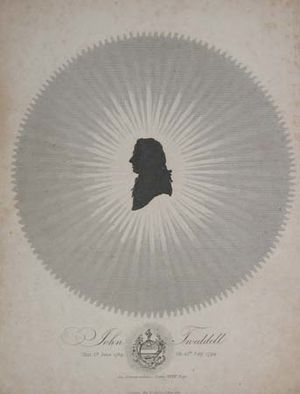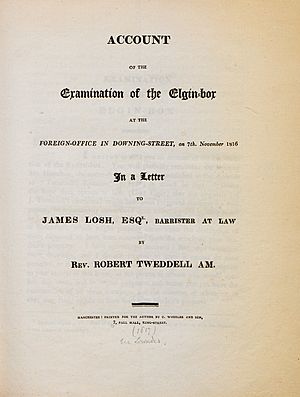Tweddell remains affair facts for kids
The Tweddell remains affair was a big disagreement in Britain that happened between 1815 and 1817. It was all about the papers, paintings, and other things that belonged to John Tweddell. He was a young lawyer and scholar who sadly passed away in Athens in 1799. The argument mainly took place in newspapers and a book written by Robert Tweddell, John's brother. Robert was very upset with Lord Elgin because he felt Elgin had not taken proper care of John's belongings. People at the time called it a "first-class scandal." Also, a trading group called the Levant Company felt that Lord Elgin, as an ambassador, was threatening their business in the Aegean Sea. They wanted to make sure no one else like him got such powerful jobs.
What Happened Before?
When John Tweddell traveled, he sent many letters home. He also spent a lot of time writing detailed journals. A large part of these journals was left in Pera, Constantinople with a merchant named Thomas Thornton because they were too big to carry easily.
John Tweddell hired a French artist named Michel-François Préaulx. They met in Constantinople and traveled together in Greece. Préaulx helped John by drawing detailed pictures of buildings in Athens. He also drew for John on Mount Athos. John Tweddell also met Louis-François-Sébastien Fauvel in Athens in 1798 or 1799. He bought many of Fauvel's drawings, which were kept with his other papers. These items were stored with Procopio Macri, who worked as a consul for the Levant Company in Athens.
After John Tweddell died, Lord Elgin arrived in Constantinople as an ambassador. He ordered that all of Tweddell's collections be sent to him.
Finding the Missing Items
What happened to John Tweddell's belongings after that is still not completely clear. But it became a big argument years later. Many of his journals and pictures had disappeared. John's brother, Robert Tweddell, later accused Lord Elgin of taking them.
Lord Elgin said that he had handled the items properly. His chaplain, Philip Hunt, supported his story. Lord Elgin's side of the story was not published until 1816. Robert Tweddell, on the other hand, was supported by people like Edward Daniel Clarke, Thomas Thornton, and John Spencer Smith, who was Lord Elgin's predecessor.
Some of John's items had actually been sent home with William Hamilton Nisbet, who was Lord Elgin's father-in-law. Other items that were with Thomas Thornton were lost in a fire. A third collection, in a trunk, got wet and was damaged. These damaged items were given to Joseph Dacre Carlyle and Philip Hunt to sort out. After that, no one knew where they went, though Hunt said they were sent on a merchant ship.
How the Problem Was Solved
The issue finally came to an end in late 1816. That's when William Nisbet gave drawings that Lord Elgin had sent with him to Robert Tweddell.
William Richard Hamilton, who used to be Lord Elgin's private secretary, met with Robert Tweddell's representatives. These were John Heys and Abraham Moore. They met at the Foreign Office in London on November 7. There were two boxes of pictures that Nisbet had returned to Lord Elgin for examination. Tweddell had already received copies of pictures of Turkish clothes from Nisbet.
They looked through the contents of the boxes. They decided that 112 pictures would be given to Robert Tweddell. Pictures that were clearly drawn by Saverio della Gatta (also known as Xavier Gatta) were kept by Lord Elgin. A record of this meeting was published, which helped to resolve the long-standing argument.
|



